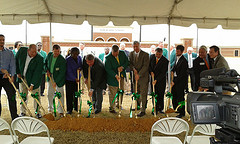 Risks at
Southern Company’s Kemper Coal plant in Mississippi?
Push those costs onto the public, of course!
Southern Company and its subsidiary Mississippi Power
got the MS Public Service Commissioners to approve super-CWIP
(Construction Work in Progress)
for Kemper Coal: automatic rate increases for MS Power customers for years.
Just like Southern Company and its biggest subsidiary Georgia Power
got the Georgia legislature to approve Super-CWIP for the new nukes
at Plant Vogtle back in 2009.
And both CWIP projects are already over budget.
How about we cancel those boondoggles and build solar and wind instead?
Risks at
Southern Company’s Kemper Coal plant in Mississippi?
Push those costs onto the public, of course!
Southern Company and its subsidiary Mississippi Power
got the MS Public Service Commissioners to approve super-CWIP
(Construction Work in Progress)
for Kemper Coal: automatic rate increases for MS Power customers for years.
Just like Southern Company and its biggest subsidiary Georgia Power
got the Georgia legislature to approve Super-CWIP for the new nukes
at Plant Vogtle back in 2009.
And both CWIP projects are already over budget.
How about we cancel those boondoggles and build solar and wind instead?
AP reported 13 December 2012, After spending $1.88 billion, Southern Co. still faces risks on plant in Kemper County,
Each day, as 2,600 construction workers toil away at Plant Ratcliffe in Kemper County, the big bet becomes more expensive. The projected cost is at least $2.8 billion, almost half a billion dollars above original expectations, and some estimates say it will go higher.
Legal challenges brought by the Sierra Club have led regulators to block the company from billing customers for the costs so far, although Southern subsidiary Mississippi Power Co. got closer to that goal with a favorable lower court ruling earlier this month.
Southern CEO Thomas Fanning stands by the plant. He says Southern’s own technology will mitigate its environmental impact and the need to exploit coal as a hedge against uncertainties in the future cost of natural gas, which is currently cheap and abundant.
But there are risks.
The Kemper plant is the most expensive project ever built by Southern subsidiary Mississippi Power Co. The company promises completion in May 2014, but some engineers monitoring construction for state regulators warn the cost could reach $3.1 billion, and completion isn’t likely until November 2014 at the earliest….
“Vogtle and Kemper County, even despite where gas prices are today, are exceedingly attractive resources for the future,” Fanning told The Associated Press.
Southern expresses confidence in technology developed and tested at Wilsonville, Ala. But Burns & Roe, the engineering firm that warns the Kemper’s cost will top $3 billion, warns “there is still a technology risk,” partly associated with scaling up the gasifier to Kemper’s larger size.
The company would sell the carbon dioxide to be pumped into the ground for energy companies seeking to push up more oil from old oil fields….
To push up more oil to burn to produce more carbon dioxide. Does that sound like a good plan to you?
The Mississippi Public Service Commission’s decision to hold off on rate increases until legal challenges are resolved stunned executives and investors, especially considering a 2008 state law allowed rate increases during construction.
“That decision surprised the investment community and we saw it our stock price,” Fanning said.
Yes, how dare a public service commission not kowtow to mighty Southern Company! Such reluctance made Fanning have to reassure his financiers.
Amy McCullough wrote for Bigger Pie Forum 25 January 2013, Southern Co.: We will recover all our money from Kemper plant,
Southern Company will seek to recover almost $3 billion plus earnings from customers, sell bonds for the rest….
CEO Tom Fanning assured the financial community that Southern Company would indeed recover all the money it has spent (and will spend) on the $2.88-billion clean coal plant under construction in Kemper County, Miss.
Back to the AP article.
The Sierra Club says Southern should convert the plant to burn natural gas, an expense that could still be costly for shareholders and ratepayers. Opponents say Mississippi Power would end up spending less money than finishing Kemper, but the company would probably try to recoup the money it’s already spent.
Just like Georgia Power can charge customers for Plant Vogtle even if it’s cancelled.
How about convert Kemper Coal to a field of solar panels? No carbon dioxide produced and no fuel required.
“I think they’ve painted themselves into a pretty tight little corner, said Louie Miller, head of the Sierra Club’s Mississippi chapter. “They decided they were going to build this thing come hell or high water.”
The AP story delves into Southern Company’s own corporate hagiography and points out Southern Company went way over budget on Plant Vogtle last time it built nukes there.
Fanning argues this time is different because inflation and interest rates are low and Southern has gotten better at big construction projects.
“Everything that I know, this plant was exceedingly well-built and well organized during the construction period,” Fanning said. “I suppose there is a theoretical risk of prudency. But in my view, this company is executing like no company in the United States.”
Executing just like Southern Company last time: already 19 months late and a billion over budget.
Fanning doubled down:
“Now look, I am not a skeptic of natural gas more than any other fuel. But you cannot plan to put all your eggs in that basket. That is imprudent,” he said. “What Mississippi is doing here is a big bet. But ultimately, long-term, it will serve well the interests of the families we serve here in Mississippi.”
Fanning knows what’s different from last time. Southern Company has gotten better at shifting all the risk onto ratepayers, the state, and the federal government. SO did it in Georgia, and just this month, they did it again in Mississippi:
Clay Chandler wrote for Mississippi Business Journal 5 March 2013, PSC approves multi-year rate plan for Kemper coal plant,
Mississippi Public Service commissioners voted 2-1 Tuesday to approve a multi-year rate plan for Mississippi Power Co.’s Kemper County coal plant.
Terms of the plan call for the utility to receive $99 million in construction-work-in-progress funds for the rest of 2013. That will create a rate increase between 12 and 13 percent for residential customers who use 1,000 kilowatt-hours per month, starting in April. The average residential customer uses about 1,100 kw/h per month, according to PSC figures. Power bills will rise by a little less than $20 per month, according to utility estimates.
In 2014, rates will increase by another 3 percent, bringing the total rate increase associated with CWiP to 15 percent. When Mississippi Power issues bonds to cover costs exceeding $2.4 billion — company CFO Moses Feagin said Monday that would likely happen in late 2014 — rates will jump again. The cumulative rate impact over the life of the seven-year plan and the bond issuance is expected to peak at 22 percent. Those calculations do not include fuel adjustment costs, which could raise or lower rates, depending on the price of fuel.
Mississippi Power, during a hearing that lasted most of Monday afternoon, had asked for more revenue, but Southern District Commissioner Leonard Bentz said the $99 million figure was appropriate because “we’re in the middle of people’s budget years. I felt that would be the best amount.”
The multi-year rate plan and the bond issuance were part of a settlement between the PSC and the utility that ended litigation brought when regulators denied last summer a 13 percent rate increase for the project. Gov. Phil Bryant signed last week two pieces of legislation that codified the settlement.
Poor SO: didn’t get the even higher rates it asked for. That probably will cut its profit margin some tiny amount.
I asked SO CEO Fanning last May, What is your exit strategy for when this big bet goes bad? Fanning danced around that question about Plant Vogtle, but he knows the answer, which is the same as for Kemper Coal: SO has shifted all the financial risk onto the public. We the ratepayers and taxpayers will get to eat the huge debt SO is running up, just like last time at Plant Vogtle.
 How about instead we cancel both projects now before they run
up the price tag even more?
We could be using bonds to build solar plants instead;
Dublin High School already is,
with zero help from Georgia Power or Southern Company.
How about instead we cancel both projects now before they run
up the price tag even more?
We could be using bonds to build solar plants instead;
Dublin High School already is,
with zero help from Georgia Power or Southern Company.
-jsq
Short Link: